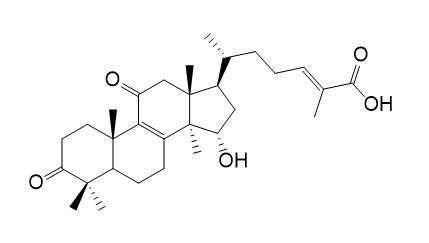Ganolucidic acid E
Ganolucidic acid E inhibits the growth of three types of human cancer cells: Caco-2, HepG2 and HeLa cells.
Inquire / Order:
manager@chemfaces.com
Technical Inquiries:
service@chemfaces.com
Tel:
+86-27-84237783
Fax:
+86-27-84254680
Address:
1 Building, No. 83, CheCheng Rd., Wuhan Economic and Technological Development Zone, Wuhan, Hubei 430056, PRC
Providing storage is as stated on the product vial and the vial is kept tightly sealed, the product can be stored for up to
24 months(2-8C).
Wherever possible, you should prepare and use solutions on the same day. However, if you need to make up stock solutions in advance, we recommend that you store the solution as aliquots in tightly sealed vials at -20C. Generally, these will be useable for up to two weeks. Before use, and prior to opening the vial we recommend that you allow your product to equilibrate to room temperature for at least 1 hour.
Need more advice on solubility, usage and handling? Please email to: service@chemfaces.com
The packaging of the product may have turned upside down during transportation, resulting in the natural compounds adhering to the neck or cap of the vial. take the vial out of its packaging and gently shake to let the compounds fall to the bottom of the vial. for liquid products, centrifuge at 200-500 RPM to gather the liquid at the bottom of the vial. try to avoid loss or contamination during handling.
Phytomedicine.2021, 84:153501.
Phytomedicine.2022, 99:154025.
Molecules.2020 ,25(16):3697.
Evid Based Complement Alternat Med.2021, 2021:5023536.
Plant Sci.2020, 301:110656.
Front Aging Neurosci.2019, 11:230
J Korean Med Ophthalmol Otolaryngol Dermatol2023, 36(1):1-20.
Plant Cell Physiol.2018, 59(1):128-141
Food Res Int.2019, 123:125-134
Processes2022, 10(10), 2008.
Related and Featured Products
Phytother Res . 2015 Nov;29(11):1744-1752.
Distinct Responses of Cytotoxic Ganoderma lucidum Triterpenoids in Human Carcinoma Cells[Pubmed:
26292672]
The medicinal mushroom Ganoderma lucidum is well recognized for its effective cancer-preventative and therapeutic properties, while specific components responsible for these anticancer effects are not well studied. Six triterpenoids that are Ganolucidic acid E, lucidumol A, ganodermanontriol, 7-oxo-ganoderic acid Z, 15-hydroxy-ganoderic acid S, and ganoderic acid DM were isolated and identified from an extract of the mushroom. All compounds reduced cell growth in three human carcinoma cells (Caco-2, HepG2, and HeLa cells) dose dependently with LC50s from 20.87 to 84.36 μM. Moreover, the six compounds induced apoptosis in HeLa cells with a maximum increase (22%) of sub-G1 accumulations and 43.03% apoptotic cells in terminal deoxynucleotidyl transferase dUTP nick end labeling (TUNEL) assay (15-hydroxy-ganoderic acid S treatment). Apoptosis was further confirmed by annexin-V staining. Four of the compounds also caused apoptosis in Caco-2 cells with maximum 9.5% increase of sub-G1 accumulations (7-oxo-ganoderic acid Z treatment) and maximum 29.84% apoptotic cells in TUNEL assay (ganoderic acid DM treatment). Contrarily, none of the compounds induced apoptosis in HepG2 cells. The different responses of the three cell lines following these treatments indicated that the bioactive properties of these compounds may vary from cells of different sites of origin and are likely acting under diverse regulatory mechanisms.
Phytother Res . 2015 Nov;29(11):1744-1752.
Distinct Responses of Cytotoxic Ganoderma lucidum Triterpenoids in Human Carcinoma Cells[Pubmed:
26292672]
The medicinal mushroom Ganoderma lucidum is well recognized for its effective cancer-preventative and therapeutic properties, while specific components responsible for these anticancer effects are not well studied. Six triterpenoids that are Ganolucidic acid E, lucidumol A, ganodermanontriol, 7-oxo-ganoderic acid Z, 15-hydroxy-ganoderic acid S, and ganoderic acid DM were isolated and identified from an extract of the mushroom. All compounds reduced cell growth in three human carcinoma cells (Caco-2, HepG2, and HeLa cells) dose dependently with LC50s from 20.87 to 84.36 μM. Moreover, the six compounds induced apoptosis in HeLa cells with a maximum increase (22%) of sub-G1 accumulations and 43.03% apoptotic cells in terminal deoxynucleotidyl transferase dUTP nick end labeling (TUNEL) assay (15-hydroxy-ganoderic acid S treatment). Apoptosis was further confirmed by annexin-V staining. Four of the compounds also caused apoptosis in Caco-2 cells with maximum 9.5% increase of sub-G1 accumulations (7-oxo-ganoderic acid Z treatment) and maximum 29.84% apoptotic cells in TUNEL assay (ganoderic acid DM treatment). Contrarily, none of the compounds induced apoptosis in HepG2 cells. The different responses of the three cell lines following these treatments indicated that the bioactive properties of these compounds may vary from cells of different sites of origin and are likely acting under diverse regulatory mechanisms.



